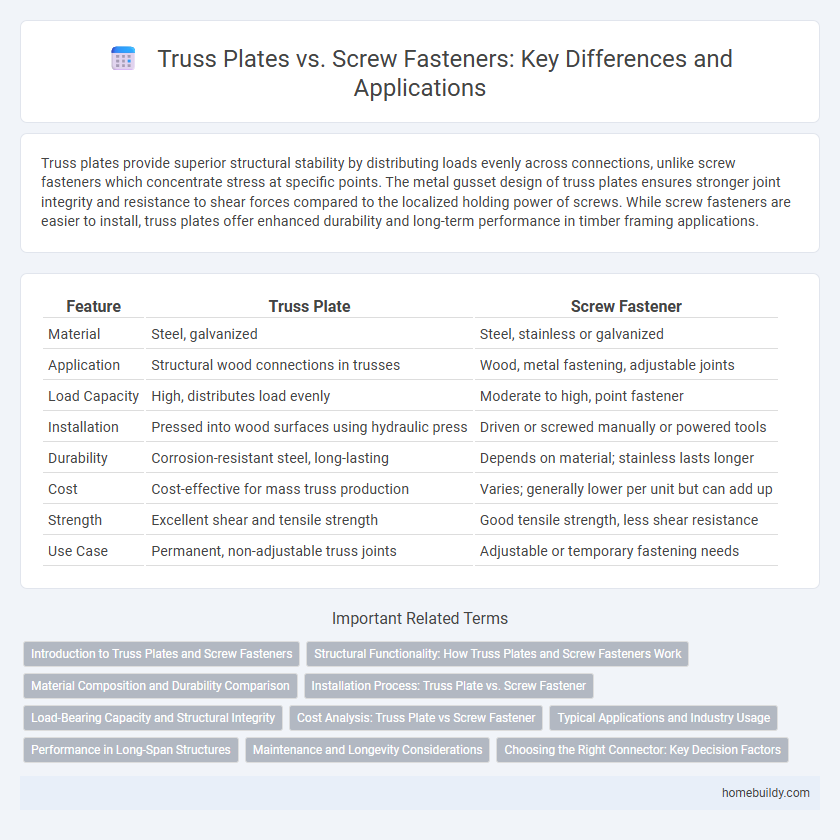Truss plates provide superior structural stability by distributing loads evenly across connections, unlike screw fasteners which concentrate stress at specific points. The metal gusset design of truss plates ensures stronger joint integrity and resistance to shear forces compared to the localized holding power of screws. While screw fasteners are easier to install, truss plates offer enhanced durability and long-term performance in timber framing applications.
Table of Comparison
| Feature | Truss Plate | Screw Fastener |
|---|---|---|
| Material | Steel, galvanized | Steel, stainless or galvanized |
| Application | Structural wood connections in trusses | Wood, metal fastening, adjustable joints |
| Load Capacity | High, distributes load evenly | Moderate to high, point fastener |
| Installation | Pressed into wood surfaces using hydraulic press | Driven or screwed manually or powered tools |
| Durability | Corrosion-resistant steel, long-lasting | Depends on material; stainless lasts longer |
| Cost | Cost-effective for mass truss production | Varies; generally lower per unit but can add up |
| Strength | Excellent shear and tensile strength | Good tensile strength, less shear resistance |
| Use Case | Permanent, non-adjustable truss joints | Adjustable or temporary fastening needs |
Introduction to Truss Plates and Screw Fasteners
Truss plates are metal connectors designed to reinforce timber joints, offering superior load distribution compared to screw fasteners. Screw fasteners provide versatile and easy-to-install connections but lack the structural rigidity and durability found in truss plates. Engineered for long-term performance in roof trusses and timber framing, truss plates ensure stable and secure joint integrity.
Structural Functionality: How Truss Plates and Screw Fasteners Work
Truss plates provide superior structural functionality by distributing loads evenly across wooden joints, ensuring enhanced stability in truss construction. Screw fasteners primarily offer point-to-point connections, which may result in localized stress concentrations and potential weakening of the wood over time. The metal composition and toothed design of truss plates create a rigid, durable connection critical for maintaining the integrity of roof and floor systems under dynamic loads.
Material Composition and Durability Comparison
Truss plates are typically fabricated from galvanized steel, offering high tensile strength and resistance to corrosion, which ensures long-term durability in structural applications. In contrast, screw fasteners are usually made from various grades of steel or stainless steel, providing sturdy connections but potentially susceptible to loosening under dynamic loads. The galvanized steel composition of truss plates gives them a distinct advantage in maintaining structural integrity and resisting environmental degradation compared to standard screw fasteners.
Installation Process: Truss Plate vs. Screw Fastener
Truss plates require precise alignment and pressing into wood joints using hydraulic or manual presses to ensure a secure fit, offering consistent load distribution. Screw fasteners involve drilling pilot holes followed by manual or powered driving, allowing for easier adjustments and faster installation but with less uniform load transfer. The installation process of truss plates is typically more labor-intensive and relies on specialized equipment, whereas screw fasteners provide flexibility and simplicity for on-site adjustments.
Load-Bearing Capacity and Structural Integrity
Truss plates provide superior load-bearing capacity compared to screw fasteners due to their larger surface area and ability to distribute forces evenly across joints, minimizing stress concentrations. Their design enhances structural integrity by maintaining consistent alignment and preventing joint movement under heavy loads, unlike screw fasteners which may loosen or fail under cyclic loading. Engineered steel truss plates also resist shear and tension forces more effectively, ensuring long-term stability in wooden frame constructions.
Cost Analysis: Truss Plate vs Screw Fastener
Truss plates generally offer a more cost-effective solution compared to screw fasteners due to lower material and installation expenses in large-scale projects. The manufacturing process of stamped steel plates reduces labor time, while screw fasteners require ongoing maintenance and replacement, increasing long-term costs. Choosing truss plates can significantly reduce overall structural assembly budgets, especially in timber framing applications.
Typical Applications and Industry Usage
Truss plates are extensively used in the construction industry for connecting timber trusses in roof and floor systems, providing strong and reliable load transfer with ease of installation. Screw fasteners are preferred in furniture manufacturing and cabinetry for their precision and adjustability, allowing for disassembly and reassembly. Both methods find applications in residential and commercial construction, with truss plates favored for structural framing and screw fasteners for detailed joinery and finishing work.
Performance in Long-Span Structures
Truss plates provide superior load distribution and enhanced structural integrity in long-span structures compared to screw fasteners, ensuring greater resistance to shear forces and bending moments. Their rigid steel design allows for consistent stress transfer across timber joints, reducing the risk of joint failure under heavy loads. Screw fasteners, while easier to install, generally offer lower hold capacity and increased potential for loosening over time, making them less reliable for critical long-span applications.
Maintenance and Longevity Considerations
Truss plates provide superior durability and require minimal maintenance due to their embedded design, which distributes loads evenly and resists corrosion and loosening over time. Screw fasteners often demand regular inspection and tightening, as they are more prone to loosening under vibration and environmental stress. Selecting truss plates enhances the structural longevity and reduces long-term maintenance costs compared to screw fasteners.
Choosing the Right Connector: Key Decision Factors
When choosing between truss plates and screw fasteners, consider load-bearing capacity, installation speed, and long-term durability. Truss plates offer high strength and uniform load distribution ideal for structural joints, while screw fasteners provide flexibility and ease of adjustment but may require more maintenance. Material compatibility and environmental exposure also influence the connector selection to ensure optimal performance and safety.
Truss plate vs Screw fastener Infographic

 homebuildy.com
homebuildy.com